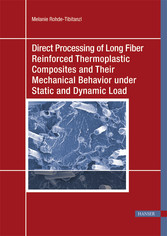Melanie Rohde-Tibitanzl
Direct Processing of Long Fiber Reinforced Thermoplastic Composites and their Mechanical Behavior under Static and Dynamic Load
PREFACE
6
TOC
7
1 INTRODUCTION
10
2 STATE OF THE ART
12
2.1 Processing of Long Fiber Reinforced Thermoplastic Composites (LFRT)
12
2.2 General mechanisms of fiber length degradation during direct processing
14
2.3 Fiber length degradation during injection molding compounding
18
2.3.1 Fiber fracture in the compounding extruder
21
2.3.2 Fiber fracture due to the valves
31
2.3.3 Fiber fracture during melt buffering and injection
31
2.3.4 Fiber alignment and fiber fracture during cavity filling
32
2.4 Determination of Fiber Length
47
2.5 Static Properties of Fiber-Reinforced Thermoplastic Composites
50
2.5.1 Micromechanics under Static Load
50
2.5.2 Modeling of Static Properties
55
2.5.3 Influences on Static Properties of Fiber-Reinforced Thermoplastic Composites
60
2.6 Dynamic Properties of Fiber-Reinforced Thermoplastic Composites
65
2.6.1 Micromechanics under Dynamic Load
65
2.6.2 Measurement Methods for Fatigue
67
2.6.3 Influences on Dynamic Properties of Fiber-Reinforced Thermoplastic Composites
72
3 CONCLUSIONS FROM THE CURRENT STATE OF THE ART — MOTIVATION & AIM
78
4 EXPERIMENTAL: METHODS & MATERIALS
81
4.1 Aim: Processing Influences on Composite Properties in Injection Molding Compounding
81
4.1.1 Injection Molding Compounding & Injection Molding
81
4.1.2 Morphology Determination
85
4.2 Aim: Influences of Fiber Length on Static Properties
90
4.3 Aim: Influences of Fiber Length on Fatigue Properties
91
4.4 Materials
95
4.4.1 Matrix Systems
95
4.4.2 Glass Fibers
96
4.4.3 Coupling Agents
96
4.4.4 Manufactured Composites
97
5 INFLUENCES ON MATERIAL PROPERTIES IN DIRECT PROCESSING
98
5.1 Influence of Screw Setup and Fiber Inlet
99
5.2 Influence of Processing Parameters and Number of Rovings
110
5.3 Conclusion of Process Investigation: Fiber Length Degradation in the IMC
117
5.3.1 Fiber Fracture in the Compounding Extruder
117
5.3.2 Fiber Fracture during Melt Buffering and Injection
128
5.3.3 Fiber Fracture during Cavity Filling
129
5.4 Fiber Alignment during Cavity Filling
130
6 INFLUENCE OF FIBER LENGTH ON COMPOSITE PROPERTIES UNDER STATIC LOAD
140
6.1 Short Term Properties of Glass Fiber Reinforced Composites
140
6.2 Modelling of Fiber Length Influence on Short Term Properties
148
6.3 Micromechanical Phenomena under Static Load
162
6.4 Conclusions from the Previous Paragraphs
164
7 INFLUENCE OF FIBER LENGTH ON COMPOSITE PROPERTIES UNDER FATIGUE LOAD
165
7.1 Long Term Properties of Glass Fiber Reinforced Composites
165
7.2 Self-Heating of the Samples during Testing
177
7.3 Modelling of Fiber Length Influence on Long Term Properties
178
7.4 Micromechanical Phenomena under Dynamic Load
184
7.5 Conclusions from the Previous Paragraphs
189
7.6 S-N-Curves of Selected Composites
190
7.6.1 Residual Strength after Dynamic Testing
194
7.6.2 Conclusions from the Previous Paragraphs
195
8 FUTURE PERSPECTIVES: TRANSFER TO REALITY
196
9 DEUTSCHE ZUSAMMENFASSUNG
203
10 ABBREVIATIONS, EQUATIONS & INDICES
205
10.1 Abbreviation
205
10.2 Formula Symbols
205
10.3 Indices
207
11 LITERATURE
209
12 OWN PUBLICATIONS RELATED TO THIS THESIS
219
Curriculum Vitae
219
© 2009-2024 ciando GmbH
 Zu Hanser-Fachbuch.de
Zu Hanser-Fachbuch.de
 Warenkorb
Warenkorb
